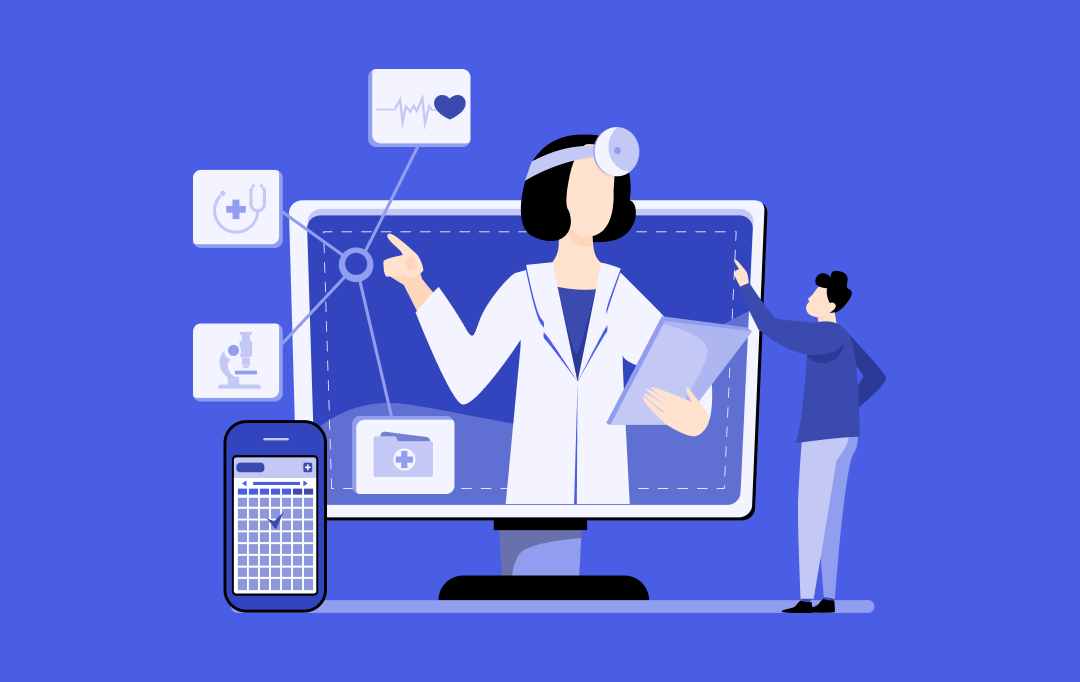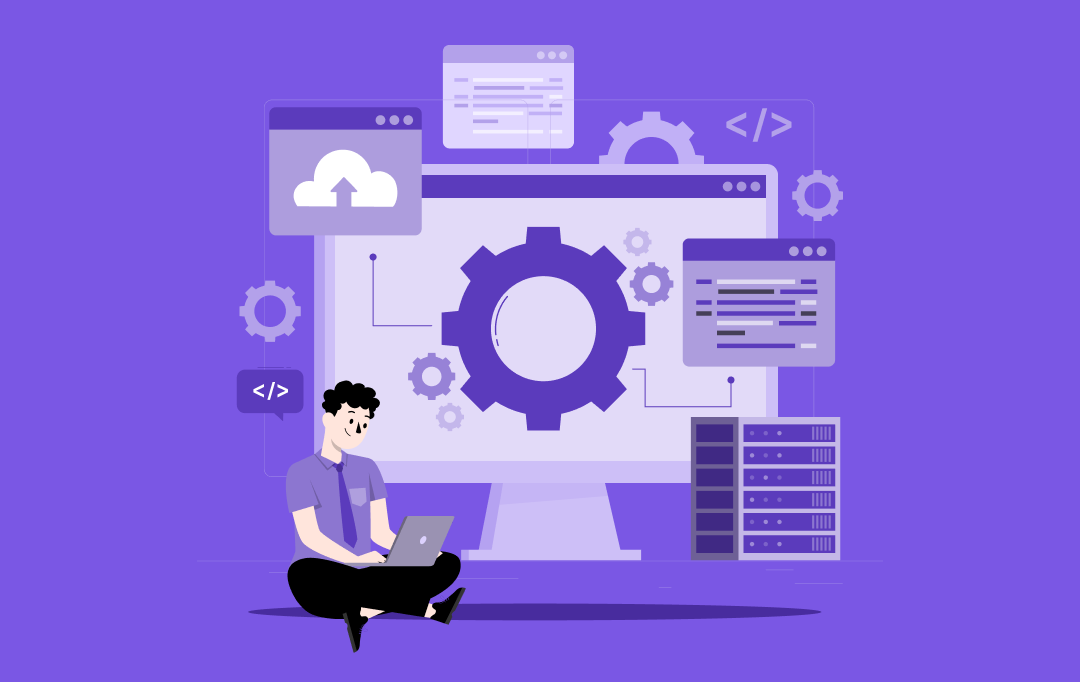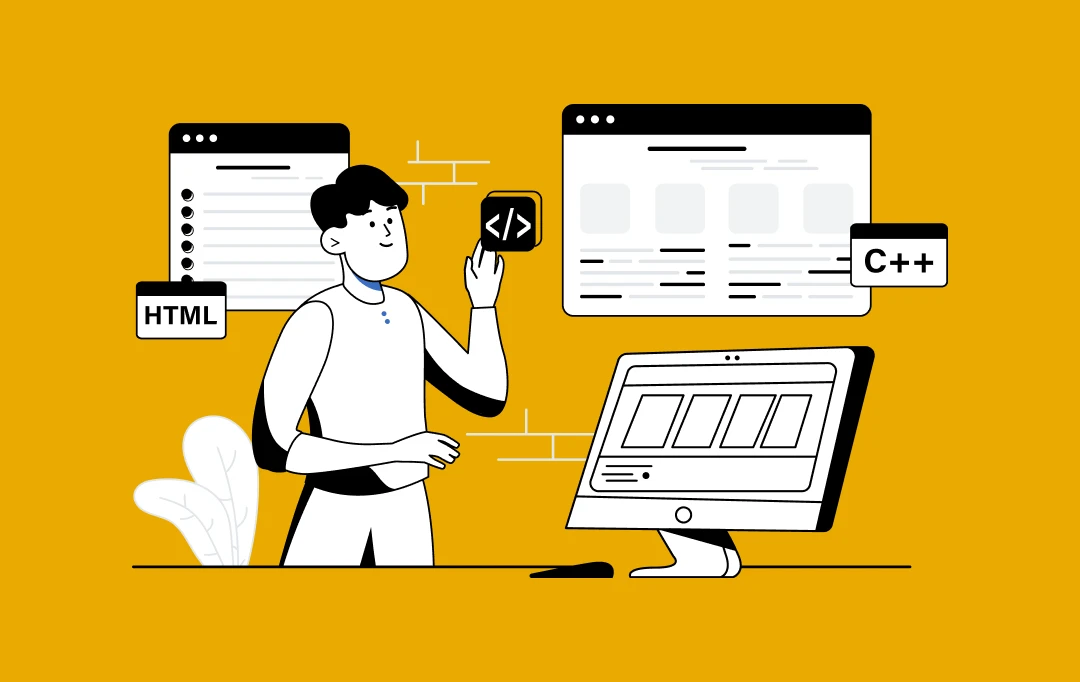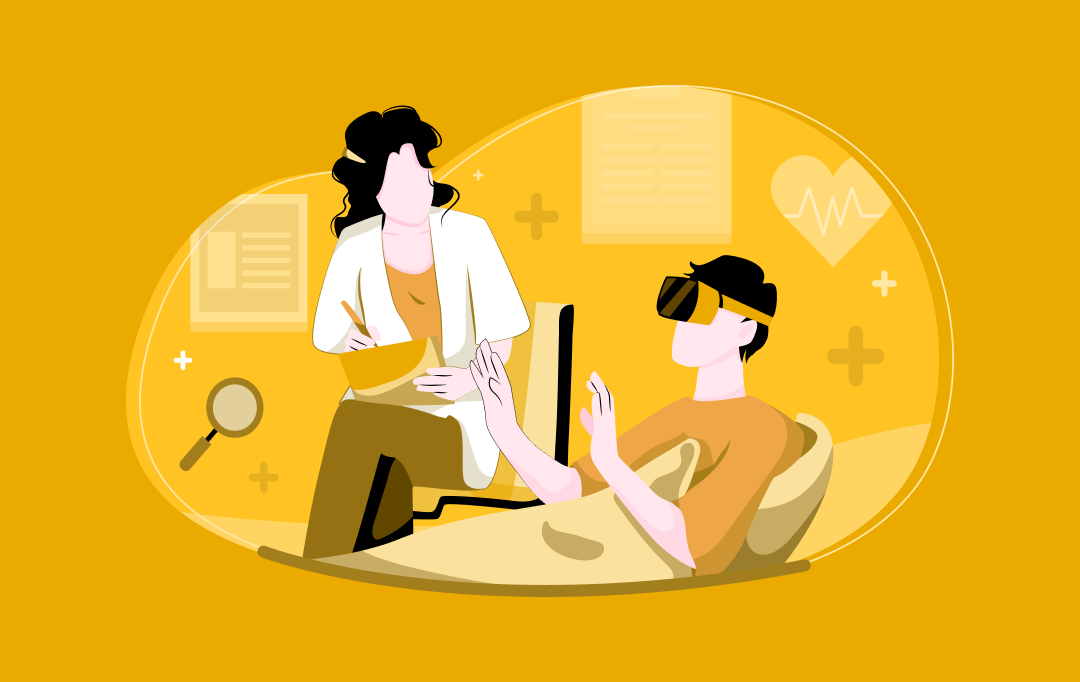As personal wellness becomes a top priority, health and fitness businesses are shifting to digital solutions like never before. Apps like Garmin Connect are revolutionizing how people track their fitness, providing everything from personalized workout plans to real-time tracking. It creates a huge opportunity for businesses looking to enter the market.
However, building an app of this caliber comes at a price.
The cost of building a fitness app like Garmin Connect typically falls between $40,000 and $300,000.
The price varies depending on factors like the app’s complexity, integration with wearable devices, features such as personalized coaching, and the level of security required.
Let’s explore the cost of building a fitness app like Garmin Connect, development methodology, monetization strategies, ongoing maintenance costs, and many more factors that ensure your app’s success and profitability.
Overview of Cash Advance Apps Like Garmin Connect
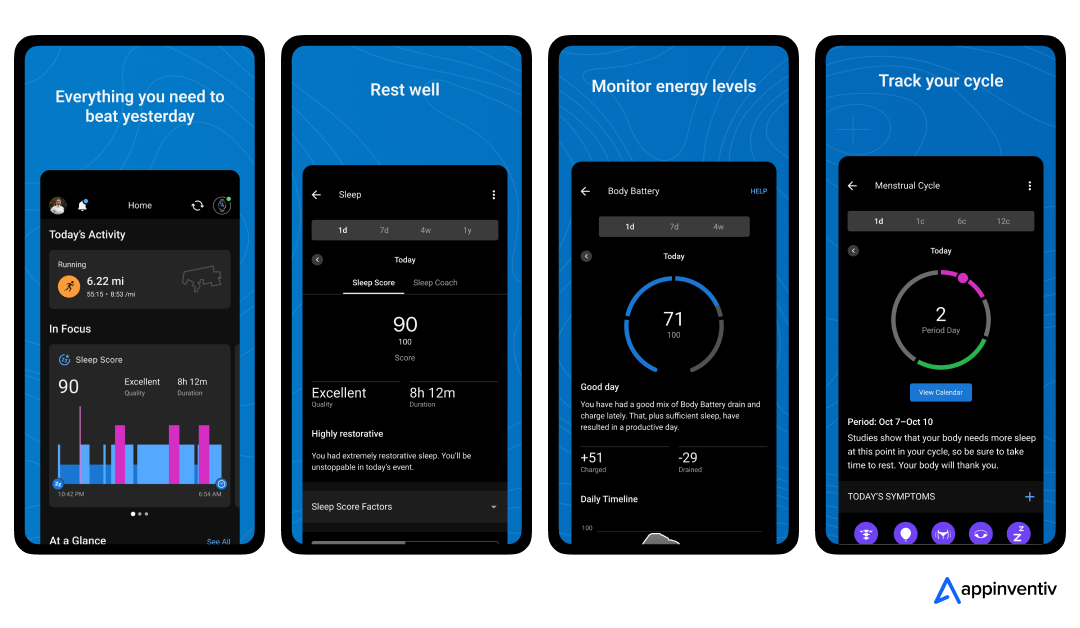
- Garmin Connect is a comprehensive health and fitness app designed to help users track their physical activities and well-being.
- Features like activity tracking, heart rate monitoring, sleep analysis, and step counting provide detailed insights into one’s daily performance.
- The app seamlessly integrates with Garmin’s range of fitness devices, allowing users to set personalized goals and track progress over time.
- Its user-friendly interface and advanced data analytics empower individuals to make informed decisions about their health and fitness journey.
How Much Does it Cost to Develop a Health and Fitness App Like Garmin Connect?
Creating a health and fitness app like Garmin Connect in Australia involves costs determined by app complexity, platform selection, and key features like activity tracking, real-time data syncing, and robust security measures. Including advanced technology and bespoke UI/UX design further influences the overall budget.
Building a fitness app like Garmin Connect generally falls between $40,000 and $300,000, based on the app’s scale and specific requirements.
| App Complexity Levels |
Features |
Duration |
| Basic
($40,000 to $60,000) |
1. Simple UI
2. Basic Navigation
3. Limited Functionality
4. Standard Security Measures
5. Basic Database Integration
6. Essential Push Notifications
7. Single Platform Compatibility (iOS or Android) |
2 to 4 months |
| Moderate
($60,000 to $120,000) |
1. Enhanced UI
2. Improved Navigation Experience
3. Expanded Functionality
4. Enhanced Security Features
5. Integration with External APIs
6. Basic Offline Functionality
7. Cross-Platform Compatibility
8. Social Media Integration |
4 to 6 months |
| Complex
($120,000 to $300,000) |
1. Highly Polished UI/UX Design
2. Advanced Navigation Features
3. Rich Functionality with Custom Features
4. Robust Security Protocols
5. Seamless Third-party Integrations
6. Advanced Offline Capabilities
7. Real-time Updates
8. Advanced Analytics and Reporting
9. Multi-language Support
10. Cross-Device Compatibility |
6 to 9 months |
How to Estimate the Cost of Developing a Health and Fitness App: A Simple Formula
Estimating the cost of creating a health and fitness app typically depends on two main factors: the total development hours required and the hourly rate charged by the development team.
Here’s a simple formula to help you calculate the overall cost of building a fitness app like Garmin Connect:
Total Cost = Development Hours × Hourly Rate
For example, if your app requires 800 hours to develop and the hourly rate is $50, the total cost would be $40,000. Remember that the final price can vary based on the app’s complexity, features, and any additional integrations you choose to include.
Valuable Factors Impacting the Fitness App Development Cost
Let’s explore the key factors influencing the health and fitness app development cost. These include app complexity, the range of fitness tracking features, and the integration of real-time data analytics and wearable device compatibility. Each factor significantly impacts development time and costs. Let’s explore the app development cost breakdown.
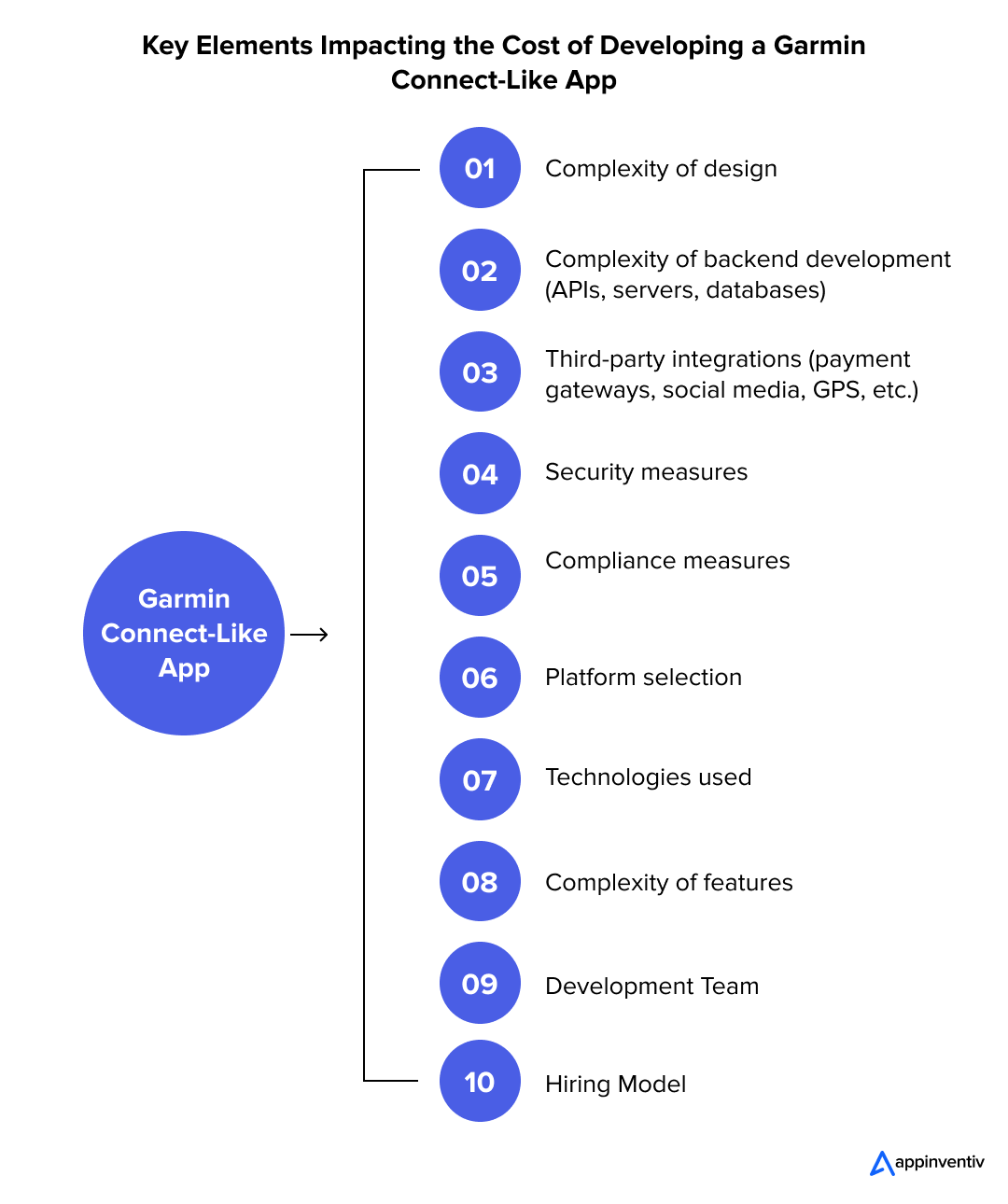
Complexity of Design
A visually appealing and user-friendly interface significantly enhances user experience but requires extensive design expertise and iterative testing. If the app includes custom animations, dynamic transitions, or a highly interactive UI, it further increases the development cost of building a fitness app like Garmin Connect. The level of design complexity directly impacts how engaging and intuitive the app feels to users.
Cost Comparison Based on Design Complexity
| Design Complexity |
Estimated Cost |
| Basic UI/UX Design |
$6,000 – $30,000 |
| Custom/Advanced UI/UX Design |
$30,000 – $50,000+ |
Complexity of Backend Development
The backend is the app’s foundation, handling data processing, storage, and synchronization across devices. Building a scalable and reliable backend involves developing robust APIs, integrating servers, and managing databases. The need for real-time data synchronization, especially for fitness tracking, adds complexity, increasing the time and cost of building a fitness app like Garmin Connect.
Third-Party Integrations
Fitness apps often require multiple integrations, such as payment gateways for subscriptions, GPS for tracking activities, and social media for sharing progress. Adding wearables like Garmin or IoT devices involves SDKs and APIs, which may have licensing costs. When you build an app like Garmin Connect, the more integrations required, the higher the complexity and expense.
Cost Comparison Based on Third-Party Integrations
| Third-Party Integration |
Estimated Cost |
| Basic Integration (Single Payment Gateway) |
$2,000 – $10,000 |
| Complex Integration (GPS, Multiple APIs, Real-Time Analytics) |
$5,000 – $15,000+ |
Security Measures
Since health and fitness apps often handle sensitive user data, implementing strong security features is essential. These may include secure authentication methods, data encryption, and compliance with privacy standards. Regular security audits and updates are necessary to protect user data, contributing to the overall development cost of building a fitness app like Garmin Connect.
Cost Comparison Based on Security Measures
| Security |
Estimated Cost |
| Basic Security Measures (SSL, Data Encryption) |
$5,000 – $8,000 |
| Advanced (Biometrics, Multi-Factor Authentication, Encryption) |
$15,000 – $100,000+ |
Compliance Measures
Depending on the target region, fitness apps may need to comply with regulations like GDPR in Europe or HIPAA in the U.S. for handling health data. These regulations require detailed documentation, specific data handling practices, and regular audits, adding to the development time and cost of building a fitness app like Garmin Connect.
Platform Selection
Choosing between iOS, Android, or both platforms affects development costs. A native app for each platform offers optimal performance but requires separate development efforts. Alternatively, cross-platform solutions like Flutter or React Native can reduce costs but might require performance or design flexibility compromises when building an app like Garmin Connect.
Cost Comparison Based on Platform Choice
| Platform |
Estimated Cost |
| Single Platform (iOS or Android) |
$30,000 – $100,000 |
| Cross-Platform (iOS and Android) |
$100,000 – $300,000+ |
Technologies Used
Advanced technologies like AI and ML for personalized fitness insights or IoT integration for wearable compatibility significantly elevate the app’s value. However, these technologies require expertise in specialized tools and frameworks, increasing the overall cost. Additionally, cloud data storage and processing services contribute to the recurring cost of building a fitness app like Garmin Connect.
| Tech Stack |
Cost Estimation |
| Basic Tech Stack (React Native, Flutter, PHP) |
$50,000 – $120,000 |
| Advanced Tech Stack (Python, AI, Blockchain) |
$120,000 – $250,000+ |
Complexity of Features
Adding sophisticated features like personalized fitness plans, progress tracking, or community engagement tools requires careful planning and extensive development efforts. Features like real-time synchronization with wearables, video tutorials, or AI-driven analytics add value but also demand higher investment in time and resources.
Cost Comparison Based on Features
| Feature |
Estimated Cost |
| Basic Features (Account setup, Secure logins, balance tracking) |
$30,000–$50,000 |
| Advanced Features (AI investment advice, real-time analytics) |
$100,000–$200,000 |
Development Team
Build an app Like Garmin Connect varies depending on whether you hire a local development team, outsource globally, or use freelance developers. A team offers better alignment with regulations and user preferences but is more expensive. Outsourcing to cost-effective regions can reduce costs but may require additional effort in managing timelines and communication.
| App Development Team |
Hourly Rates (Approx) |
| Project Manager |
$25 to $30 |
| Tech Lead (Backend / Frontend) |
$28 to $30 |
| Sr. Mobile App Developer |
$25 to $30 |
| Sr. Web & Backend Developer |
$24 to $30 |
| DevOps |
$25 to $30 |
| Business Analyst |
$20 to $25 |
| UX/UI |
$20 to $25 |
| QA |
$20 to $25 |
Hiring Model
Your hiring approach significantly influences costs and development speed. Building an in-house team ensures full control but incurs higher costs to build an App Like Garmin Connect. Outsourcing to a dedicated app development team or freelancers offers flexibility and cost-effectiveness but requires careful selection to maintain quality.
| Hiring Models |
Key Points |
Advantages |
Challenges |
| In-house Team |
Ideal for businesses needing full control over development. |
Direct supervision, tailored expertise. |
High upfront and ongoing costs. |
| Freelancers |
Best for small-scale or specific development tasks. |
Affordable, flexible hiring. |
Risk of delays and inconsistent quality. |
| Outsourcing |
Suitable for end-to-end app development with diverse expertise |
Scalability, reliable quality. |
Higher cost compared to freelancers. |
Unveiling the Hidden Cost of Developing an App Like Garmin Connect
There are times when businesses encounter unexpected expenses during app development. These hidden costs often stem from post-launch maintenance, additional feature enhancements, or unforeseen third-party integration fees. Proper planning and a detailed budget can help mitigate such surprises.
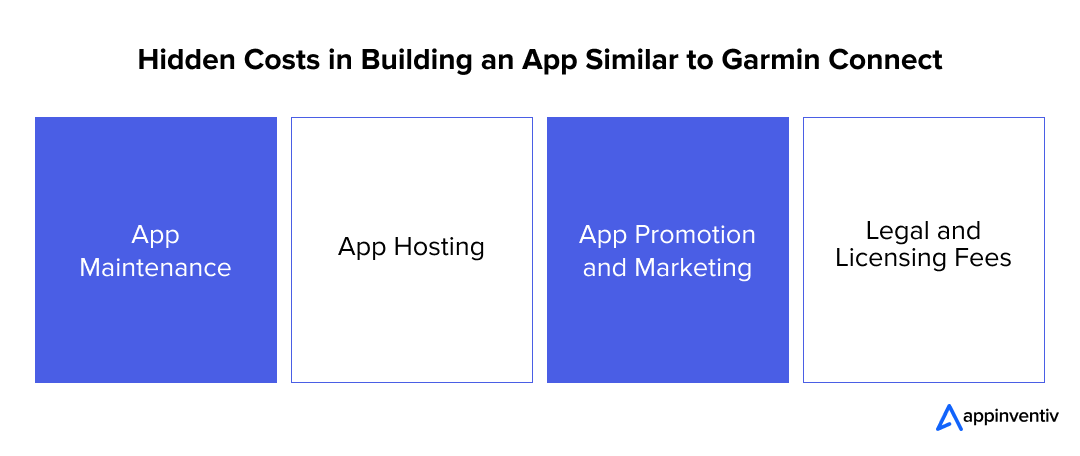
App Maintenance
After the initial launch, maintaining the app is an ongoing cost that includes fixing bugs, releasing updates, and ensuring compatibility with the latest OS versions. Regular maintenance is essential to provide a seamless user experience and keep the app functional as technology evolves. Over time, maintenance costs can accumulate to a significant portion of the overall budget when you build your fitness app.
Action Points:
- Schedule regular updates to fix bugs, improve features, and ensure compatibility with new OS versions.
- Allocate a dedicated budget for ongoing technical support and performance monitoring saves cost to create a fitness app like Garmin Connect,
- Use analytics tools to identify user pain points and prioritize maintenance tasks by minimizing fitness app development cost.
App Hosting
Hosting involves managing the app’s backend servers and storing user data securely in the cloud. As the user base grows, hosting requirements increase, leading to higher cost of building a fitness app like Garmin Connect, bandwidth, and server scalability. These recurring expenses are critical for maintaining reliable app performance and data accessibility when you build your own fitness app.
Action Points:
- Choose a scalable cloud hosting provider to accommodate user growth efficiently save fitness app development costs.
- Optimize backend architecture to reduce storage and bandwidth requirements by minimizing cost to create a fitness app like Garmin Connect.
- Regularly review hosting costs and upgrade plans to maintain performance while controlling expenses.
App Promotion and Marketing
Building a high-quality app is only half the journey; marketing it effectively is equally important. Costs for digital marketing campaigns, app store optimization, social media ads, and partnerships can quickly add up. A well-executed promotional strategy ensures visibility and user acquisition but requires a substantial financial commitment.
Action Points:
- Develop a comprehensive marketing plan, including app store optimization and social media campaigns, by saving costs to create a fitness app like Garmin Connect.
- Choose a fitness app developer to track ROI for each promotional activity and reallocate funds to high-performing strategies.
- Leveraging partnerships or influencer collaborations to expand reach helps save health and fitness app development costs.
Legal and Licensing Fees
Compliance with regional laws and obtaining necessary licenses for APIs, third-party integrations, or wearable device compatibility are often overlooked expenses. Additionally, drafting legal documents like privacy policies and terms of service may involve legal consultation fees. These hidden costs of building a fitness app like Garmin Connect are essential for protecting both the business and its users.
Action Points:
- Research and comply with all regional laws and regulations related to your app.
- Obtain necessary licenses for APIs, third-party integrations, and wearable compatibility.
- Hire legal experts to draft robust privacy policies, terms of service, and other required documents.
Recognizing and planning for these hidden costs ensures that your app meets user expectations and remains sustainable and competitive in the long run.
Cost Optimization Strategy While Building a Health and Fitness App
Developing a high-performing health and fitness app in today’s competitive market requires a well-thought-out strategy to ensure efficiency, affordability, and scalability. Let’s uncover the most effective strategies to streamline health and fitness app development in Australia and achieve remarkable outcomes without sacrificing quality.
Developing an MVP
Creating a Minimum Viable Product (MVP) helps you focus on the core features essential for user engagement. By launching an MVP, you can gather valuable feedback from early users and make improvements before scaling. This approach minimizes initial development costs and reduces the risk of investing in unnecessary features.
Prioritizing Necessary Features
Identify and prioritize features that align with your app’s primary goals and user needs. Avoid adding complex functionalities in the initial phase to save both time and budget. Starting with a streamlined feature set ensures a faster time-to-market and allows for future scalability based on user demands.
Leveraging Cross-Platform Development
Using cross-platform frameworks like Flutter or React Native enables you to create apps for multiple operating systems with a single codebase. This approach significantly reduces development time and costs compared to building separate native apps. Cross-platform solutions also ensure a consistent user experience across devices.
Outsourcing to Cost-Effective Regions
Partnering with development teams in cost-effective regions allows you to access skilled professionals at lower hourly rates. This approach can help you allocate resources to other areas like marketing and maintenance. Choose an experienced fitness app developer with a proven track record to ensure quality remains uncompromised by saving fitness app development costs.
Monetization Model for An App Like Garmin Connect
Let’s explore some effective ways to monetize a health and fitness app. Offering tiered access to advanced features can help create a steady revenue stream. Additional income can be generated through offering exclusive content or features within the app. Partnerships with relevant brands or services can also provide opportunities for profitable collaborations.
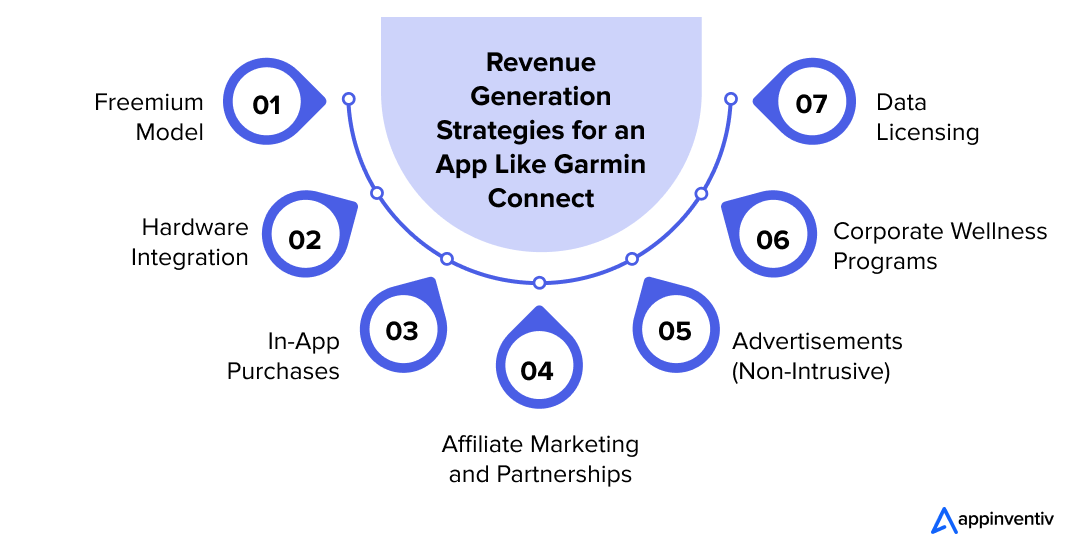
Freemium Model
A freemium model allows users to access essential features like activity tracking, step counting, and basic fitness analytics for free, attracting a wide user base. To generate revenue, a premium subscription unlocks advanced features such as personalized coaching, in-depth performance insights, recovery recommendations, and seamless integration with third-party apps. This tiered structure ensures accessibility while incentivizing users to upgrade for a more comprehensive experience.
Hardware Integration
Garmin Connect can serve as an ecosystem hub for Garmin’s hardware, such as smartwatches, fitness trackers, and cycling computers. The app motivates users to invest in the company’s hardware by offering exclusive features and seamless syncing with Garmin devices. This symbiotic relationship between the app and devices enhances user loyalty and boosts hardware sales.
In-App Purchases
In-app purchases provide users with the flexibility to customize their experience. Offerings like personalized training plans, advanced analytics tools, virtual race entries, or digital rewards can cater to specific fitness goals. This model empowers users to enhance their fitness journey while generating a steady revenue stream from incremental purchases.
Affiliate Marketing and Partnerships
The app can partner with fitness brands, nutrition companies, or sports equipment manufacturers to recommend relevant products. By incorporating affiliate marketing, Garmin Connect can earn a commission for every sale made through in-app links, creating a revenue source that aligns with users’ fitness interests and needs.
Advertisements (Non-Intrusive)
Integrating non-intrusive ads within the app’s free version allows monetization without compromising the user experience. Fitness-related advertisements, such as workout gear, health supplements, or local gyms, can be displayed strategically. This approach ensures a revenue stream while keeping ads relevant to the user base.
Corporate Wellness Programs
Garmin Connect can partner with corporations to offer wellness programs to improve employee health. By providing bulk subscriptions or customized versions of the app for corporate use, businesses can track employee activity and promote healthier lifestyles. This model benefits companies and employees while providing a lucrative market for Garmin.
Data Licensing
Anonymized and aggregated user fitness data can be valuable for research institutions, fitness brands, and healthcare providers. By licensing this data, Garmin Connect can support innovation in fitness and health while ensuring strict compliance with data privacy regulations such as GDPR, fostering trust and additional revenue.
Step-by-Step Process to Develop a Health and Fitness App
Here is a proper step-by-step process to build a fitness app. From conceptualization and market research to post-launch support, each stage ensures your app meets user needs and stands out in the competitive market.
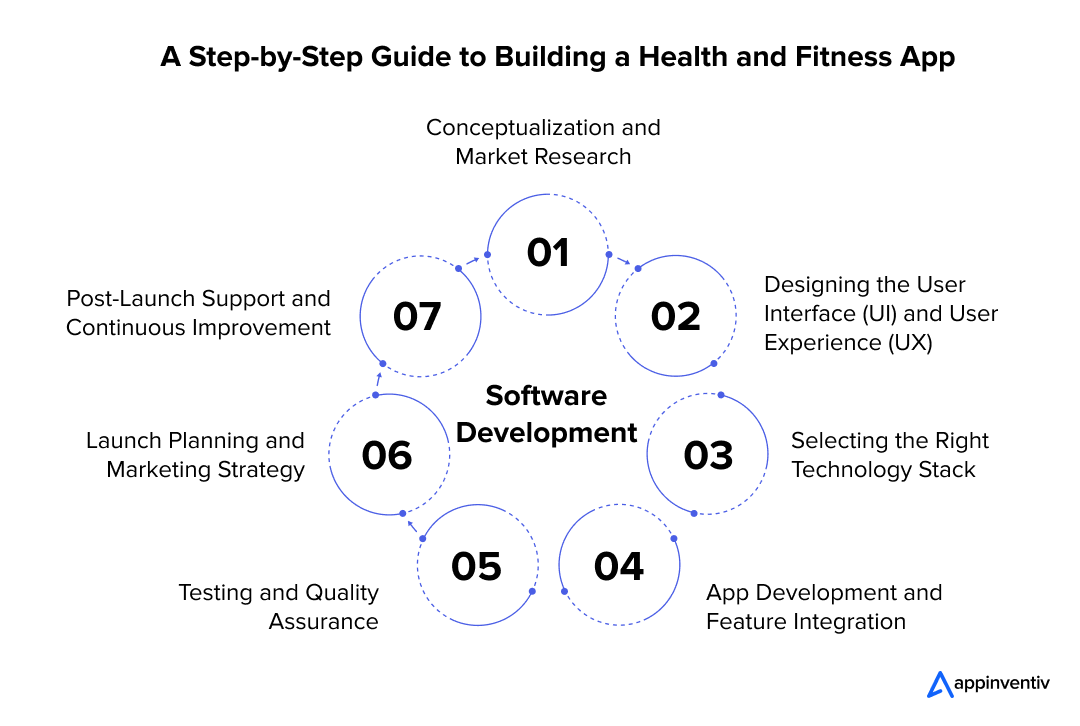
Conceptualization and Market Research
The first phase involves identifying the app’s purpose, target audience, and unique selling points. In-depth market research helps you understand user needs, competitor strategies, and trends in the health and fitness sector. This phase sets the foundation for creating an app that stands out and solves a specific problem in the market.
Designing the User Interface (UI) and User Experience (UX)
UI/UX design ensures the app is intuitive and user-friendly. The goal is to create a seamless, visually appealing experience that encourages users to engage with the app regularly. Prototypes and wireframes are developed to map the flow, ensuring the design aligns with user expectations and app functionality.
App Development and Feature Integration
In this phase, the app is coded and developed. Core features such as user profiles, fitness tracking, and integration with third-party devices are implemented. The app’s architecture is built to be robust and scalable, ensuring the app can handle future updates and additional features, saving the cost of building a fitness app like Garmin Connect.
Design Instruction – Give the logo of Health-e People and the app’s mockup.
Selecting the Right Technology Stack
Choosing the appropriate technology stack is key to ensuring scalability, security, and performance. It includes selecting frameworks, programming languages, and tools that best fit the app’s features and target platform. A solid tech stack also helps reduce development time and improves long-term sustainability when you build an app like Garmin Connect.
Testing and Quality Assurance
Rigorous testing ensures the app works as expected across all devices and platforms. It includes functionality testing, performance testing, and security audits to identify and fix bugs before launch. Ensuring high-quality standards during this phase is vital for delivering a smooth user experience and maintaining a good app rating.
Launch Planning and Marketing Strategy
Before launching the app, a comprehensive marketing strategy should focus on user acquisition and engagement. It includes setting up app store optimization (ASO), social media campaigns, and partnerships with influencers or fitness brands.
A well-planned launch ensures the app gains visibility and attracts the right users when you build an app like Garmin Connect.
Post-Launch Support and Continuous Improvement
After launch, continuous monitoring and user feedback are essential for identifying areas of improvement. Regular updates and bug fixes ensure the app remains functional and competitive. Post-launch support is also key to keeping users satisfied and building loyalty over time, impacting the cost of building a fitness app like Garmin Connect.
Strategies to Create an App Superior to Garmin Connect
Let’s explore the top strategies to build a fitness app that outperforms Garmin Connect. By focusing on user personalization, seamless integrations, and cutting-edge features, your app can deliver a superior experience and stand out in the competitive health and fitness market.
Intuitive UI/UX
A user-friendly interface and seamless experience ensure users stay engaged with the app. Focus on simple navigation, responsive design, and easy access to features like fitness tracking and personalized goals. An intuitive layout enhances usability, making the app enjoyable for beginners and advanced fitness enthusiasts when you build an app like Garmin Connect.
Advanced Features
Incorporating advanced features such as real-time activity tracking, integration with wearables, and personalized workout plans can set your app apart. Offering smart analytics that track progress over time and adaptive fitness programs based on user data will enhance user engagement.
These features provide a competitive edge and create a more customized experience, contributing to the overall fitness app development cost breakdown.
Here are some prominent features of a fitness app like Garmin Connect;
User-Side Features:
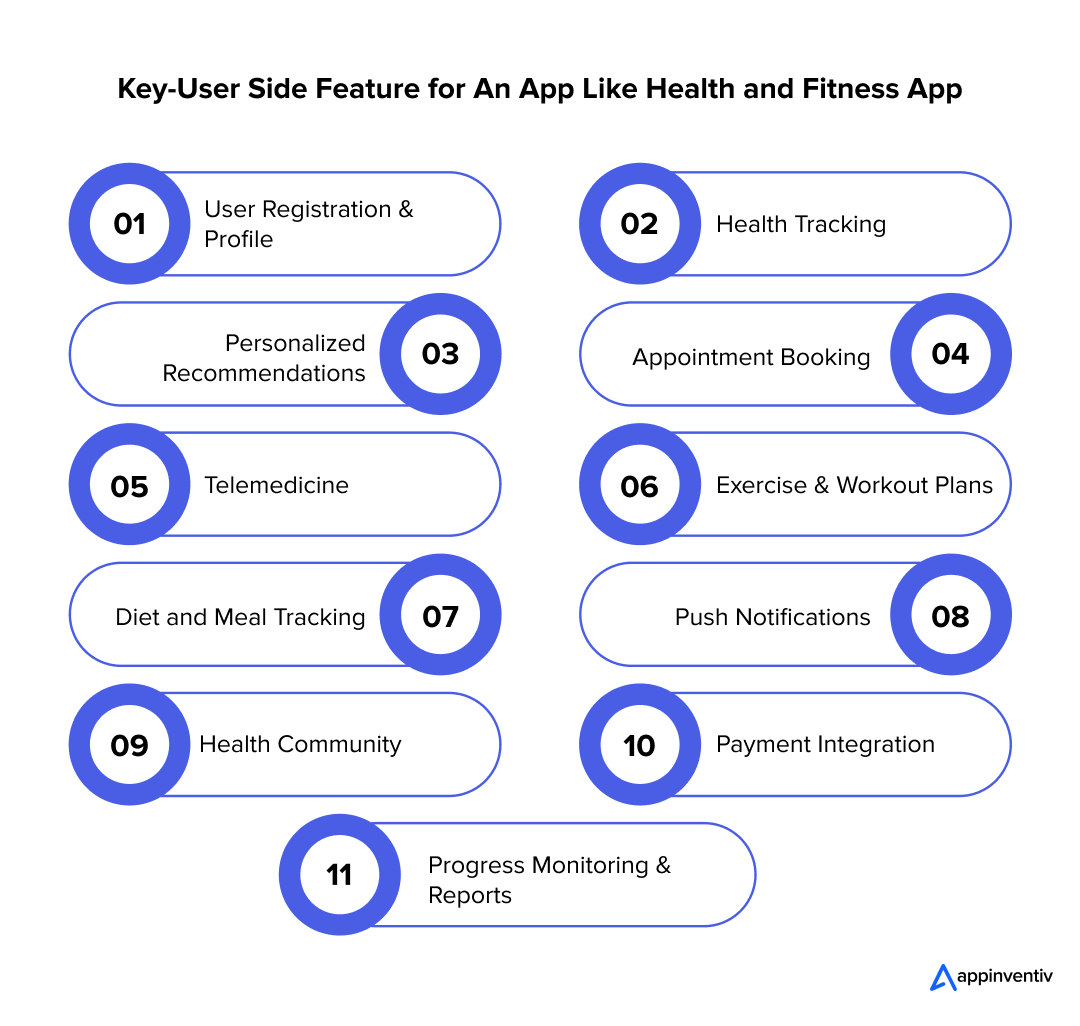
- User Registration & Profile: Users can create personal accounts and manage their health data.
- Health Tracking: Tracks key health metrics like steps, calories burned, heart rate, sleep patterns, and activity levels.
- Personalized Recommendations: Provides users customized fitness plans, nutrition advice, and health tips based on their goals and data.
- Appointment Booking lets users schedule consultations with healthcare professionals or wellness experts.
- Telemedicine: Enables users to connect with doctors via video calls, chat, or phone for consultations.
- Exercise & Workout Plans: Offers pre-designed workout plans or lets users create custom routines.
- Diet and Meal Tracking: Helps users track food intake, nutritional values, and caloric consumption.
- Push Notifications: Sends reminders for workouts, medication schedules, or appointments.
- Health Community: Connects users with others for motivation, advice, or social interaction.
- Payment Integration: Facilitates in-app purchases like premium content or booking paid services.
- Progress Monitoring & Reports: Provides insights into users’ health progress through charts and graphs.
Admin-Side Features:
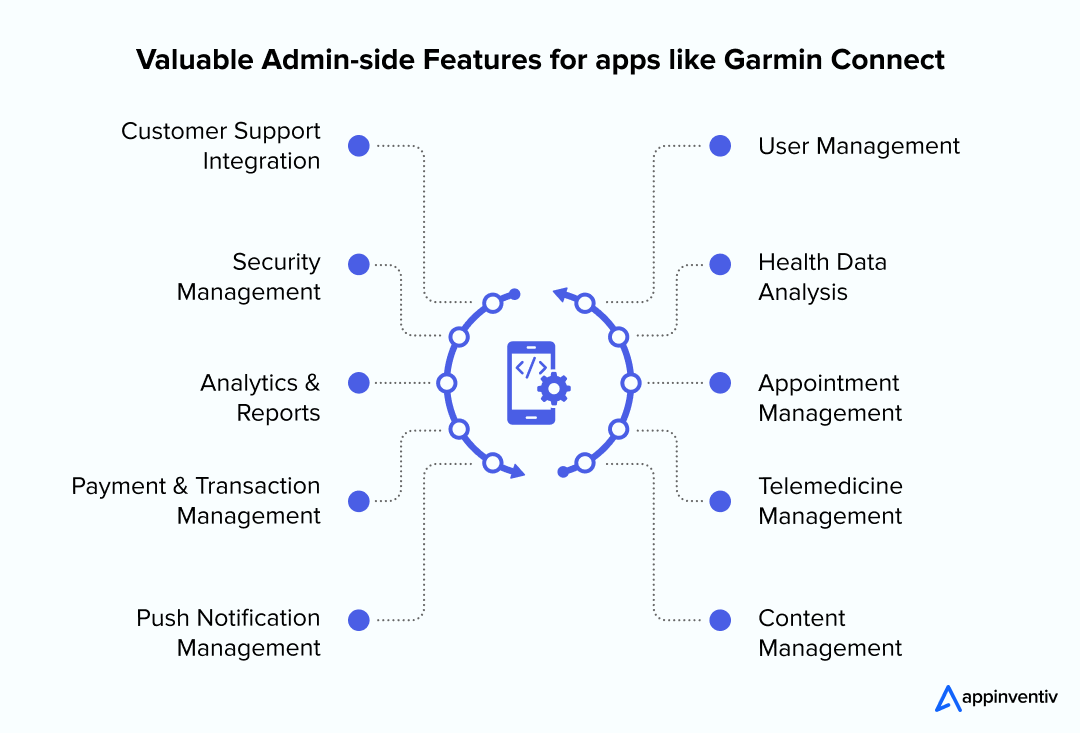
- User Management: Admins can manage user accounts, monitor activity, and resolve issues.
- Health Data Analysis: Admins can analyze aggregated health data for trends and insights.
- Appointment Management: Allows admins to schedule, reschedule, or cancel appointments and assign doctors or experts.
- Telemedicine Management: Admins can manage telemedicine sessions, approve requests, and monitor session quality.
- Content Management: Manages content related to fitness plans, diet charts, blog posts, and health articles.
- Push Notification Management: Admins can create and schedule push notifications to engage users.
- Payment & Transaction Management: Handles transactions for services, subscriptions, or in-app purchases.
- Analytics & Reports: Provides detailed analytics and reports on app performance, user behavior, and engagement.
- Security Management: Admins oversee data encryption, user privacy, and overall app security.
- Customer Support Integration: Allows admins to monitor user queries complaints, and provide customer service.
Robust and Scalable Technologies
Choose a solid technology stack that ensures the app is reliable, fast, and secure. Leveraging cloud-based infrastructure allows scalability, ensuring the app can handle an increasing user base and data volume without compromising performance. Investing in scalable technologies helps support future updates and feature additions without overhauling the core system.
How Appinventiv Can Help You in Developing a Health and Fitness App
Appinventiv is a recognized mobile app development company in Germany, empowering businesses across industries to transform their ideas into impactful solutions. With extensive health and fitness sector expertise, we are fully equipped to develop a robust, user-friendly app like your ideal fitness platform.
- Proven Track Record with 3000+ Successful Projects: Appinventiv has delivered over 3000 projects across various industries, highlighting our proficiency and dedication to excellence.
- Global Team of 1600+ Experts: Our team of 1600+ skilled professionals brings together creativity, technical expertise, and deep industry knowledge to create tailored solutions.
- Innovative and Streamlined Development Process: Our client-focused development approach ensures transparency, on-time delivery, and specifically crafted solutions to align with your health and fitness goals.
- Recognition for Excellence: Awarded ‘Tech Company of the Year’ at the Times Business Awards 2023, Appinventiv is a leader in mobile app innovation.
Partner with Appinventiv to create a health and fitness app that sets new industry standards and delivers an exceptional user experience.
FAQs
Q. How much does it cost to develop an app like Garmin Connect?
A. The cost to develop an app like Garmin Connect typically ranges from $100,000 to $500,000, depending on factors like the complexity of features, platform compatibility (iOS, Android, or both), user interface design, integration with wearable devices, and the development team’s location and expertise.
Q. How long does developing an app like Garmin Connect take?
A. Developing an app like Garmin Connect can take 6 to 18 months. The timeline depends on the scope of features, such as real-time activity tracking, syncing with wearables, and social features. Additional time may also be required to test and optimize the app for various devices and operating systems.
Q. What benefits do businesses leverage using a health and fitness app?
A. Businesses can leverage health and fitness apps to improve customer engagement, encourage healthier lifestyles, and increase brand loyalty. These apps provide valuable data on user health metrics, which can be used for targeted marketing or developing personalized services. Moreover, health and fitness industry businesses can enhance their reputation by offering valuable tools that align with consumers’ wellness goals.
Product Development & Engineering
IT Managed & Outsourcing
Consulting Services
Data Services
Didn't find what you're looking for? Let us know your needs, and we'll tailor a solution just for you.



